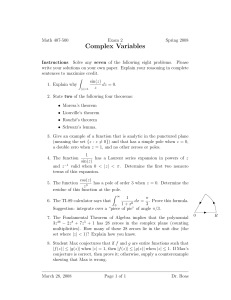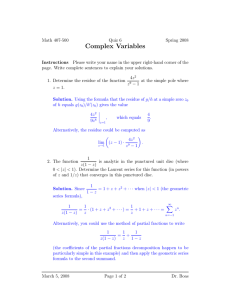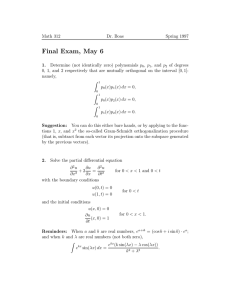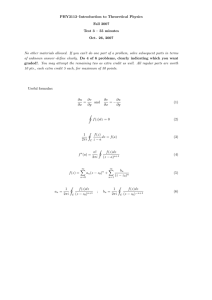Complex Variables
advertisement
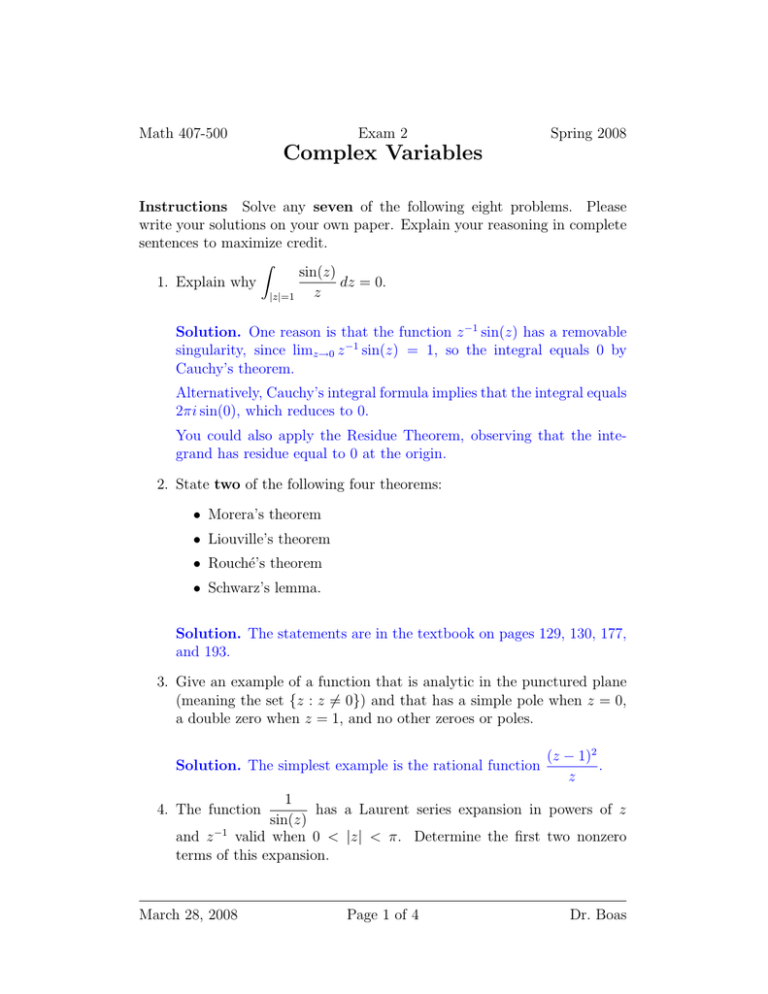
Math 407-500
Exam 2
Spring 2008
Complex Variables
Instructions Solve any seven of the following eight problems. Please
write your solutions on your own paper. Explain your reasoning in complete
sentences to maximize credit.
Z
sin(z)
1. Explain why
dz = 0.
z
|z|=1
Solution. One reason is that the function z −1 sin(z) has a removable
singularity, since limz→0 z −1 sin(z) = 1, so the integral equals 0 by
Cauchy’s theorem.
Alternatively, Cauchy’s integral formula implies that the integral equals
2πi sin(0), which reduces to 0.
You could also apply the Residue Theorem, observing that the integrand has residue equal to 0 at the origin.
2. State two of the following four theorems:
• Morera’s theorem
• Liouville’s theorem
• Rouché’s theorem
• Schwarz’s lemma.
Solution. The statements are in the textbook on pages 129, 130, 177,
and 193.
3. Give an example of a function that is analytic in the punctured plane
(meaning the set {z : z 6= 0}) and that has a simple pole when z = 0,
a double zero when z = 1, and no other zeroes or poles.
Solution. The simplest example is the rational function
(z − 1)2
.
z
1
has a Laurent series expansion in powers of z
sin(z)
and z −1 valid when 0 < |z| < π. Determine the first two nonzero
terms of this expansion.
4. The function
March 28, 2008
Page 1 of 4
Dr. Boas
Math 407-500
Exam 2
Spring 2008
Complex Variables
Solution. Since sin(z) = z − 16 z 3 + O(z 5 ), it follows that
1
1
1
1 2
1
4
= ·
= · 1 + z + O(z )
sin(z)
z 1 − 16 z 2 + O(z 4 )
z
6
1 1
= + z + O(z 3 ).
z 6
1
I used the binomial series trick: 1−u
= 1 + u + u2 + · · · when |u| < 1.
You could also do explicit long division.
cos(z)
5. The function
has a pole of order 3 when z = 0. Determine the
z3
residue of this function at the pole.
Solution. Since cos(z) = 1 − 12 z 2 + O(z 4 ), it follows that
1
1/2
cos(z)
= 3−
+ O(z),
3
z
z
z
so the residue (the coefficient of the 1/z term in the Laurent series)
equals −1/2.
Alternatively, you could use the formula for the residue at a multiple
pole to compute the residue as follows:
1 d2
1 d2
3 cos(z)
= 1 (− cos(0)) = − 1 .
· 2 z ·
·
cos(z)
=
3
2
2! dz
z
2 dz
2
2
z=0
z=0
Z
∞
1
π
dx
=
. Prove this formula.
1 + x6
3
0
Suggestion: integrate over a “piece of pie” of angle π/3.
6. The TI-89 calculator says that
0
Solution. If γ is the illustrated contour, then there is one pole inside
(at eπi/6 ), so
Z
1
1
2πi
πi
πi/6
dz = 2πi Res
;e
=
= e−5πi/6 .
6
6
πi/6
5
1+z
6(e )
3
γ 1+z
On the other hand, we can parametrize the three parts of the contour
respectively by z = x (where x goes from 0 to R), z = Reiθ (where
March 28, 2008
Page 2 of 4
Dr. Boas
R
Math 407-500
Exam 2
Spring 2008
Complex Variables
θ goes from 0 to π/3), and z = teπi/3 (where t goes from R to 0).
Therefore the contour integral equals
Z
0
R
1
dx +
1 + x6
Z
0
π/3
1
Rieiθ dθ +
1 + R6 e6iθ
The middle integral is O(1/R5 ) because
1
iθ
≤ R
Rie
R6 − 1
1 + R6 e6iθ
Z
0
R
1
eπi/3 dt.
1 + t6
(when R > 1).
Putting the pieces together, we find that
Z
R 1
πi −5πi/6
πi/3
e
= 1−e
dx + O(1/R5 ).
6
3
1
+
x
0
Taking the limit as R → ∞ shows that
Z ∞
1
πi e−5πi/6
dx =
·
.
1 + x6
3 1 − eπi/3
0
√
√
√
Now√ie−5πi/6 = i(− 23 − 12 i) = − 23 i + 12 , and 1 − eπi/3 = 1 − ( 12 + 23 i) =
1
− 23 i, so the answer indeed reduces to π3 .
2
Z
1 ∞ dx
Alternatively, you could rewrite the problem as
and use
2 −∞ 1 + x6
a semi-circular contour. Then you have to compute three residues (at
eπi/6 , e3πi/6 , and e5πi/6 ). Passing to the limit, you get the answer
1
1
1
1
,
· 2πi
+
+
2
6e5πi/6 6e15πi/6 6e25πi/6
which again simplifies to π3 .
7. The Fundamental Theorem of Algebra implies that the polynomial
3z 28 − 2z 8 + 7z 5 + 1 has 28 zeroes in the complex plane (counting
multiplicities). How many of these 28 zeroes lie in the unit disc (the
set where |z| < 1)? Explain how you know.
March 28, 2008
Page 3 of 4
Dr. Boas
Math 407-500
Exam 2
Spring 2008
Complex Variables
Solution. The idea is to apply Rouché’s theorem. Suppose f (z) =
−7z 5 and g(z) = 3z 28 − 2z 8 + 7z 5 + 1. On the unit circle where |z| = 1,
we have
|f (z) + g(z)| = |3z 28 − 2z 8 + 1| ≤ 3 + 2 + 1 = 6 < 7 = |f (z)|.
Thus the hypothesis of Rouché’s theorem is satisfied on the boundary
circle, and we deduce that the functions f (z) and g(z) have the same
number of zeroes inside the circle. Since f (z) has a zero of order 5 at
the origin, it follows that our original polynomial g(z) has 5 zeroes in
the unit disc (counting multiplicity).
8. Student Max conjectures that if f and g are entire functions such that
|f (z)| ≤ |g(z)| when |z| = 1, then |f (z)| ≤ |g(z)| when |z| ≤ 1. If Max’s
conjecture is correct, then prove it; otherwise, supply a counterexample
showing that Max is wrong.
Solution. Max’s conjecture is wrong. Indeed, if f (z) is the constant
function 1 and g(z) = z, then |f (z)| = |g(z)| when |z| = 1, but |f (z)| >
|g(z)| for every point z such that |z| < 1.
Nonetheless, Max’s conjecture can be salvaged by adding a supplementary hypothesis. If the function g(z) has no zeroes in the closed unit
disc, then Max’s statement does hold. Indeed, in this case the quotient
f (z)/g(z) is analytic, and its modulus is at most 1 on the boundary
circle, so the maximum-modulus principle implies that its modulus is
at most 1 everywhere in the unit disc.
March 28, 2008
Page 4 of 4
Dr. Boas
